by
Dr. K.E. Berntsson
The Swedish National Board of Fisheries
Göteborg, Sweden
The Swedish eel fishery is mainly an inshore one and it is carried on along all Swedish coasts except the northern part of the east coast.
In order to describe the structure of this fishery, the coast is divided into four sections: the west coast, the Sound (Öresund), the south coast and the east coast (Fig. 1).
On the west coast the eel fishery is not perhaps as important as that on the other coast areas. This is due to the fact that silver eels migrate straight out from this coast and do not pass along it. Consequently this is mainly a yellow eel fishery only (Fig. 2).
The catch has increased during the last few years. The fishermen use small fyke nets and eel pots to catch the eels. The increase in catch is probably due to their using synthetic material in the fyke nets and therefore they can operate more unite than before. Fishing goes on for most of the year except in the winter. There is a peak in the catch in the spring and also one in the autumn.
In the Sound (Öresund) there is both a silver eel fishery and also a yellow eel one. The migrating silver eels are caught with pound nets mostly in October and November. The yellow eel fishery is carried on during the whole year except in January, February and March. The catch in this fishery has increased since the early fifties, mainly due to the fact that the fishermen then begun to use special fyke nets which consist of two small fykes facing each other and with a leader between (Fig. 3). As the bottom of the Sound is more or less level and smooth, they place these units in long chains with 30 to 40 fyke nets in each chain. Two fishermen working together in one boat can operate and tend three to four hundred fyke nets.
The main silver eel fishery is carried on along the south and east coast. As the diagram shows (Fig. 4) the major part of the total eel catch comes from these coastal areas. Although the catch of yellow eel is included also in these statistics, the silver eel catch forms the major part. As the diagram shows, the catch has decreased from 1955 to 1969 on the south coast but on the east coast the catch is about the same. It is the belief of the fishermen that the decrease in catch on the south coast is a consequence of the increase in fishing intensity of the east coast.
The migrating silver eels are caught in large pound nets (Fig. 5). The use of this gear is traditional and the operating method has not changed very much in recent times. The nets are, in the main, the same type but the performance of each may very depending on the topography of the bottom. In areas with a soft bottom the nets are often fixed with poles driven into the bottom. In areas with a hard bottom the nets are supported by floats and are secured with anchors. There is a tendency among the fishermen to go farther and farther out from the coast with their nets. In such an event it is common to change from poles to floats.
The decrease in the number of pound nets from 1958 to 1968, as shown in Figure 6, is explained by the fact that the fishermen replace their old nets by longer and more expensive ones which are more efficient. On the south coast this is quite evident. On the east coast, however, the number has increased, but this is due to the fact that more and more of the units are being used northwards along this coast.
Another development in this fishery is that increasing numbers of progressive fishermen are becoming trained as amateur-divers. This makes it easier for them to locate the big nets in the right place and makes it possible for them to check their gear when necessary.
DISCUSSION:
| McGrath | - | what is the depth of pound net? |
| Berntsson | - | up to 10 m. |
| McGrath | - | what is the reason for size limits? |
| Berntsson | - | the west coast (37 cm) has no silver eels and many males the east coast (45 cm) has no males the Sound (31 cm), density of stock in Sound is so high that low minimum is acceptable. |
| v. Brandt | - | the longest leader for a German pound net is 600 m. What is the maximum in Sweden? |
| Berntsson | - | 300 m. |
| v. Brandt | - | described the circular pattern of fish movement following along a leader: which tends to limit the effectiveness of a long leader and necessitates provision of traps at intervals along the leader to ensure fish will not escape capture due to circular pattern of movement out of it. |
| Vickers | - | do you have any information on exploitation rate and tag loss? |
| Berntsson | - | annual tagging experiment shows a catch of 60 per cent. No tag loss over short period (two months). |
| Moriarty | - | what are the tag recoveries after one year? |
| Berntsson | - | 1 to 2 per cent up to two year absence. |
| Deelder | - | where do recaptures occur? |
| Berntsson | - | in region of fishery; none from middle of Baltic. |
| Larsen | - | eels tagged in River Murenso were recaptured on coast. |
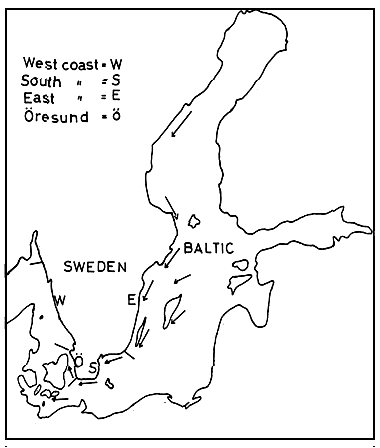
Fig. 1
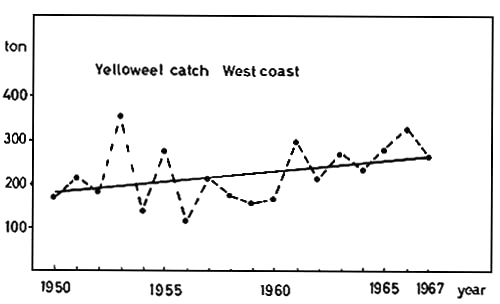
Fig. 2
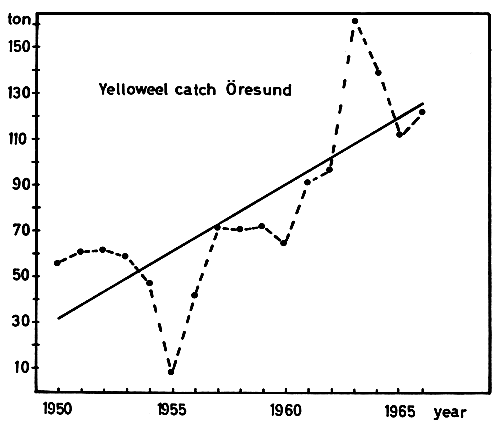
Fig. 3

Fig. 4
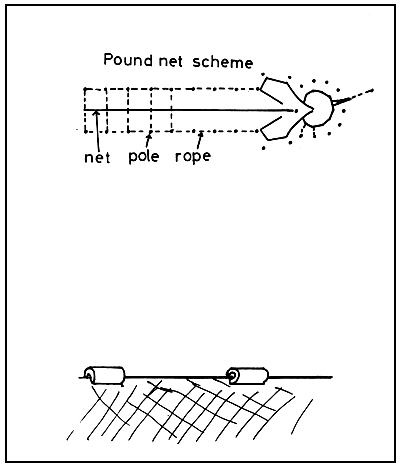
Fig. 5
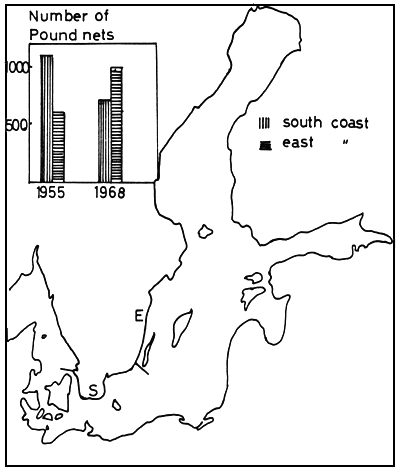
Fig. 6